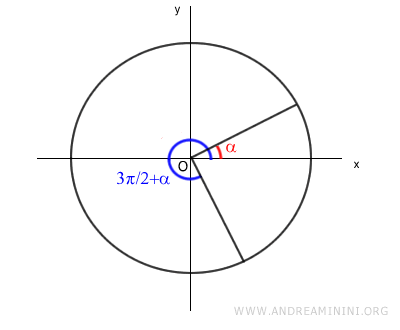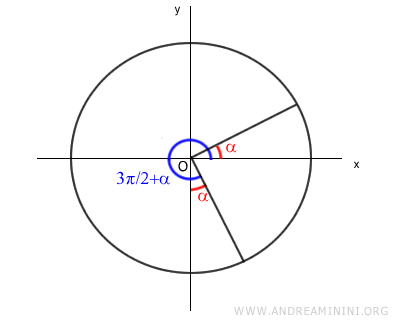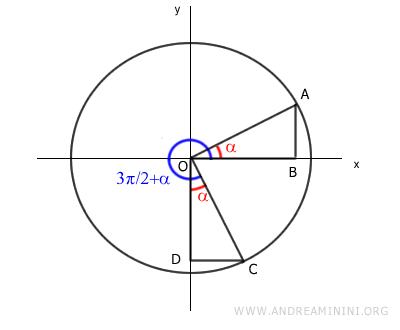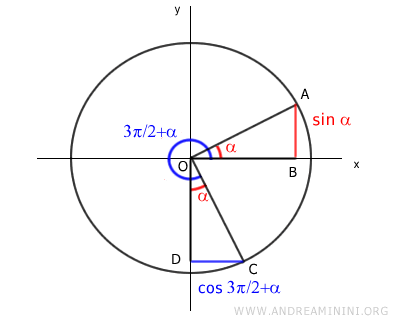Associated Angles α and 3π/2+α in Trigonometry
In trigonometry, the angles alpha (α) and 3π/2+α are associated angles and follow these transformation formulas: $$ \sin( \frac{3 \pi }{2} + \alpha ) = - \cos(\alpha) $$ $$ \cos( \frac{3 \pi }{2} + \alpha ) = \sin(\alpha) $$ $$ \tan( \frac{3 \pi }{2} + \alpha ) = - \cot(\alpha) $$ $$ \cot( \frac{3 \pi }{2} + \alpha ) = - \tan(\alpha) $$
The angles α and 3π/2+α (270°+α) are associated angles, meaning they have the same absolute values for sine, cosine, tangent, and cotangent.
Proof and Explanation
Let’s examine an angle α and the angle 3π/2+α on a unit circle.

The two angles differ by 270°, which is equivalent to 3π/2.

As a result, the right triangles OAB and OCD are congruent because they share the same acute angle (α) and the same hypotenuse length (OA=OC).

Since the triangles are congruent, they have identical angles and side lengths.
The segment OB is equal to the segment OD.

Segment OB represents the cosine of α on the positive x-axis, while segment OD represents the sine of 3π/2+α on the negative y-axis.
$$ - \sin ( \frac{3 \pi}{2} + \alpha ) = \cos \alpha $$
Multiplying both sides of the equation by -1:
$$ (-1) \cdot ( - \sin ( \frac{3 \pi}{2} + \alpha ) ) = (-1) \cdot \cos \alpha $$
$$ \sin ( \frac{3 \pi}{2} + \alpha ) = - \cos \alpha $$
Therefore, the sine of 3π/2+α equals the negative of the cosine of α.
The segment AB is equal to the segment CD.

Segment AB represents the sine of α, while segment CD represents the cosine of 3π/2+α.
Thus, the cosine of 3π/2+α is equal to the sine of α.
$$ \cos ( \frac{3 \pi}{2} + \alpha ) = \sin \alpha $$
After determining the transformation formulas for sine and cosine, the tangent and cotangent formulas can be derived indirectly.
The tangent is defined as the ratio of sine to cosine:
$$ \tan ( \frac{3 \pi}{2} + \alpha ) = \frac{ \sin (3 \frac{\pi}{2} + \alpha) }{ \cos (3 \frac{\pi}{2} + \alpha) } $$
Since sin(3π/2+α) = -cos(α) and cos(3π/2+α) = sin(α):
$$ \tan ( \frac{3 \pi}{2} + \alpha ) = \frac{ - \cos \alpha }{ \sin \alpha } = - \cot \alpha $$
Therefore, the tangent of the angle 3π/2+α is the negative of the cotangent of α.
The cotangent is defined as the ratio of cosine to sine:
$$ \cot ( \frac{3 \pi}{2} + \alpha ) = \frac{ \cos (\frac{3 \pi}{2} + \alpha) }{ \sin (3 \frac{\pi}{2} + \alpha) } $$
Given that sin(3π/2+α) = -cos(α) and cos(3π/2+α) = sin(α):
$$ \cot ( \frac{3 \pi}{2} + \alpha ) = \frac{ \sin \alpha }{ - \cos \alpha } = - \tan \alpha $$
Thus, the cotangent of 3π/2+α is the negative of the tangent of α.
A Practical Example
Let’s calculate the sine of 330°:
$$ \sin 330° $$
We rewrite it as the sum of 270° + 60°:
$$ \sin (270° + 60°) $$
In radians, this becomes:
$$ \sin (\frac{3 \pi}{2} + \frac{\pi}{3} ) $$
The angles 3π/2+α and α are associated angles, where α=π/3 (or 60°).
$$ \sin( \frac{3 \pi }{2} + \alpha ) = - \cos(\alpha) $$
$$ \sin( \frac{3 \pi }{2} + \frac{\pi}{3} ) = - \cos( \frac{\pi}{3} ) $$
Therefore, the sine of 330° equals the negative of the cosine of 60°.
Knowing that the cosine of 60° is 1/2, its negative value is -1/2.
$$ \sin( \frac{3 \pi }{2} + \frac{\pi}{3} ) = - \cos( \frac{\pi}{3} ) = - \frac{1}{2} $$
Thus, the sine of 330° is -1/2:
$$ \sin 330° = - \frac{1}{2} $$
In conclusion, simplifying the trigonometric function sin(330°) to the first quadrant as -1·cos(60°) made the calculation straightforward.
And so forth.
